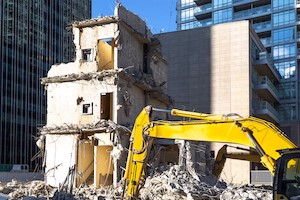Federal tax policy incentivizes demolition over reuse
 As we envision postpandemic social changes to our urban environment, we must do so within the context of policy changes needed to sustain our existing building stock – including our dwindling built-heritage inventory.
As we envision postpandemic social changes to our urban environment, we must do so within the context of policy changes needed to sustain our existing building stock – including our dwindling built-heritage inventory.
It might be surprising to many that Canada is the only G7 nation without a national law protecting such assets. A national historic site designation confers no protection: it merely “commemorates.” Provincial legislation – notably the Ontario Heritage Act, informed by Parks Canada’s Standards and Guidelines for the Conservation of Historic Places in Canada, devolves most responsibility for built-heritage protection to municipalities.
But never mind a lack of protection, federal policy actually encourages the demolition of the built environment (heritage or otherwise) through a tax system that incentivizes destruction over reuse.
Federal bias against reuse began when William Clifford Clark served as deputy minister of finance (1932-1952). This was the heyday of planned obsolescence (the antithesis of “sustainability”), and Clark’s public contempt for existing buildings (he said in his book they looked pre-industrial) was reflected in his redesign of Canada’s tax system during the 1940s. This had disastrous consequences for built heritage and created a market dynamic strongly biased in favour of demolition.
The revised Income Tax Act offered lucrative tax advantages to building owners with a wrecking ball, including:
- Tax deductions based upon the presumption that commercial, industrial and rental residential buildings lost two-thirds of their value within 10 years (today that would be about half their value, measured in constant dollars);
- Avoidance of tax recapture: If it was later revealed that the cumulative deductions exceeded what the building actually lost in market value, the owner wouldn’t have to pay them back (called “recapture”) if the building was demolished; and
- Deduction of any remaining book value after depreciation: The owner could also claim whatever building value remained on the books as a tax-deductible loss, because the building was no longer there and must have gotten lost (called “terminal loss”).
As for reuse, Clark apparently considered restoration so marginal that he left its tax treatment to guesswork. Nowadays, when someone asks the Canada Revenue Agency for an advance ruling on deductibility for a restoration or rehabilitation, it produces a document explaining that it can’t explain in advance. But officials will list their opinions on multiple disqualifications, such as asbestos removal (too much of an improvement?), as well as on “expenses that extend the useful life of your property.”
Other levels of government followed the federal lead. For example, municipal property tax structures often favour parking lots. In the City of Ottawa, parking lots will pay substantially less property tax per dollar of evaluation than retail stores or factories. Capitalizing the tax savings on converting a building into a parking lot could be as much as a grant worth hundreds of thousands of dollars.
Then there is the GST/HST. In the 1990s, the federal government doubled its sales taxes on renovations. As a “revenue-neutral” quid pro quo, it included a “substantial” renovation rebate – but only on condition that the building is gutted, destroying 90 percent of nonstructural elements. An owner could be disqualified for not producing enough demolition waste.
But there are other “revenue-neutral” rebates to help offset the GST, such as a standard new housing rebate for additions to Canada’s housing stock. However, if you create new housing by inserting units into an existing residential building (like a new rental in the basement or attic), that rebate doesn’t apply – the only example of new housing in Canada that is automatically disqualified.
Governments don’t restrict their bias to taxation. They are also very unlikely to lease rehabbed buildings. Even government heritage officials who speak on behalf of older buildings usually don’t work in them (older buildings are too challenging for the layout of work cubicles)
With almost amusing irony, Canada Revenue Agency is headquartered in the historic Connaught Building on Mackenzie Avenue in Ottawa.
As well, in some provinces, for example, Ontario, provincial funding for school boards (per student, per square foot) is lower for a rehabbed school than a new one.
Governments just don’t seem to like old buildings.
How big is the problem?
Real estate is Canada’s largest industry, at over $264 billion worth of gross domestic product in 2020 – more than manufacturing or oil and gas.
Canada’s “built environment” – the entirety of our existing stock of over 15 million buildings – has an estimated value of about $6.5 trillion, the largest collection of privately owned physical assets in the country. The destructive implications of the current taxation regime affect primarily income properties – $3 trillion worth of commercial, industrial and rental-residential built assets across Canada.
“Sustaining” all that building stock in good repair is a $121-billion business – $85 billion residential and $36 billion nonresidential. Fix-up is one of the largest industries in Canada, creating over 810,000 Canadian jobs on the residential side alone (61 per cent of total construction-related jobs, with over $50 billion in wages). It is by far the largest single category of “development” of real estate in Canada. Although government policies carry titles like Build Smart: Canada’s Buildings Strategy and National Housing Strategy, they are dead silent about the fate of existing assets and the repair/renovation industry.
Is current policy sustainable?
This planned obsolescence represents an inefficient expenditure of resources – financial, labour and materials – and also creates massive landfill waste annually. Until the 1990s, Canada destroyed so many buildings that one-third of Canadian landfill deposits consisted of used construction material. In 2012 it was down to 27 percent (partly due to higher tipping fees), but the quantity was still mountainous.
Notwithstanding the federal government’s politically correct “green” rhetoric, its policy is anything but green in the area of the built environment.
How does Canada compare to other developed nations?
Planned obsolescence was repudiated by the World Commission on Environment and Development in the 1987 Brundtland Report, which established guiding principles for what we know today as sustainable development. It denounced unsustainable “consumption and production patterns,” notably in urbanization, and commended public opinion that countered the “indiscriminate demolition of existing buildings and historic districts.”
The 1992 UN Global Strategy for Shelter to the Year 2000 said, “objectives must be set …for the upgrading and maintenance of the existing housing stock in terms both of the scale of the activity and of the housing standards to be met.” The second UN Conference on Human Settlements (1996) repeated this objective, saying:
- “We, the States participating in the UN Conference on Human Settlements… are committed to promoting the upgrading of existing housing stock through rehabilitation and maintenance.”
- “A fundamental principle in formulating a realistic shelter policy is (to) emphasize the increased use and maintenance of existing stock.”
- “Governments at the appropriate levels should adopt an enabling approach to shelter development, including the renovation, rehabilitation, upgrading and strengthening of the existing housing stock in both rural and urban areas.”
These guiding principles for sustainable development have been widely embraced globally, but not by Canada.
In 2020, the European Union undertook a Renovation Wave – a “flagship” program to at least double or even triple renovation (to the equivalent of C$404 billion) by 2030 (“35 million buildings”).
It is high time for Canada to catch the renovation wave, to ride it to legislative change for the built environment and align it with the current “green” political narrative of the Liberal government.
Green rhetoric makes for good political copy. At every opportunity, Prime Minister Justin Trudeau trolls for sustainability virtue points – and previous governments have done the same. The reality remains, however, that since the 1940s federal tax policy is actually antithetical to our concepts of sustainability. It is nothing short of legislated destruction.
Going green means revising policy – starting with the Income Tax Act and the GST. Only when it has done so can Canada claim to bring sustainability to where we live.
This article first appeared on Policy Options and is republished here under a Creative Commons license.








